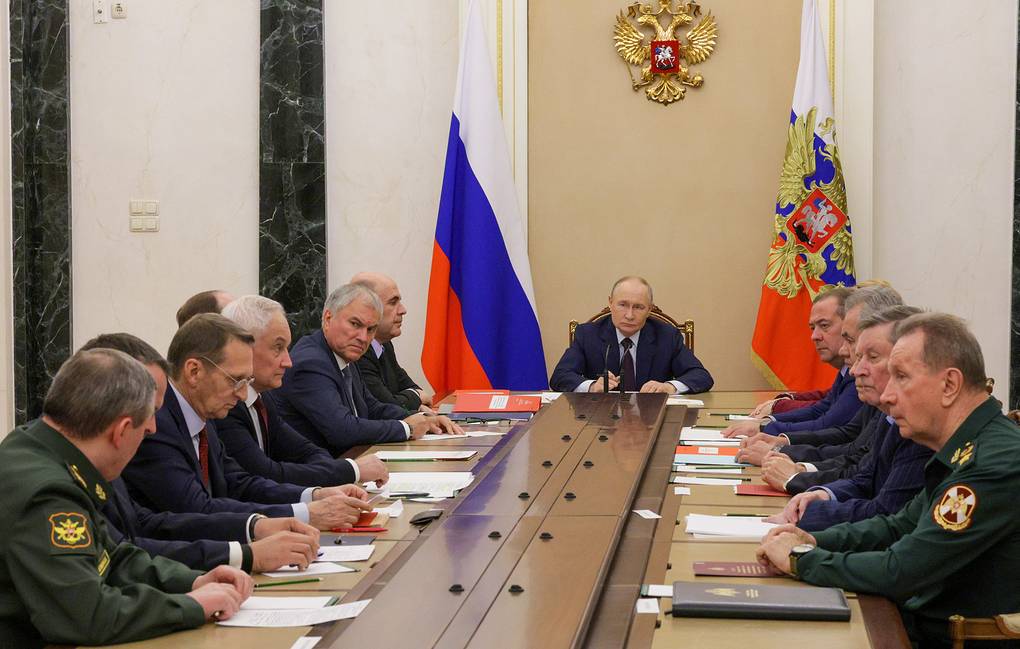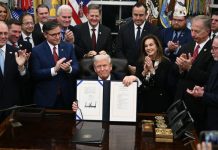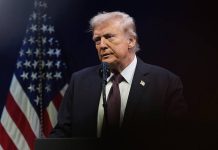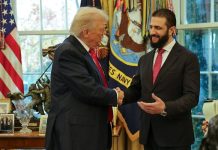Top stories from the Russian press on Thursday, November 6th
MOSCOW – Russia responds to Trump’s statements about resuming nuclear tests by signaling it may do the same; Canada moves forward with legislation to seize Russia’s sovereign assets; and Russia and the US see surge in trade under Trump. These stories topped Thursday’s newspaper headlines across Russia.
Vedomosti: Russia ups nuclear ante amid Trump’s escalatory statements
At a meeting of the Security Council on Wednesday, State Duma Speaker Vyacheslav Volodin drew President Vladimir Putin’s attention to the statement made by US President Donald Trump on October 30, in which Trump instructed the Pentagon to “immediately” prepare for conducting nuclear tests so as not to fall behind China and Russia. A discussion ensued, ending with Putin ordering that the issue of a potential US resumption of nuclear weapons testing be examined and analyzed. Experts interviewed by Vedomosti argue that if the US resumes nuclear testing, it will pave the way for Russia, China, and others to do the same, seriously weakening global non-proliferation efforts. Russia, for its part, has indicated that it won’t just stand pat amid the US moves.
Hearing the statements coming out of Washington, the Russian authorities feel they need to show that they are ready to act symmetrically, research fellow at the Institute of World Economy and International Relations Alexander Ermakov told the newspaper. The length of time it would take Russia to prepare for nuclear tests depends on the condition of the test site, which is not publicly disclosed. However, most likely, the timeframe would be several months.
If Washington resumes nuclear testing first, it will effectively give Moscow, Beijing, and other states the go-ahead to follow suit, Director of the Center for Military-Economic Studies at the Institute of Global Military Economics and Strategy Prokhor Tebin told Vedomosti. If that happens, it would be a serious blow to the global nuclear non-proliferation regime and to international security. “All the more so since the Russian side is demonstrating that, in practice, everything needed for testing is already in place,” he added.
Russia is currently signaling its willingness to up the nuclear ante, but it should be noted that it’s the US that sent things in this direction, Deputy Director of the Center for Comprehensive European and International Studies at the Higher School of Economics Dmitry Suslov believes.
According to the expert, there are two ways the United States could go now that Russia has made its position clear. The first and more reasonable option would be to accept Russia’s proposal to maintain for another year the quantitative limits outlined in the New START Treaty, refrain from escalatory steps such as resuming nuclear testing or conducting exercises simulating preemptive strikes against Russia, and instead begin a dialogue on arms limitation and strategic stability under new conditions. The second path, Suslov continued, is escalatory: rejecting Russia’s proposal, issuing unfounded accusations of alleged covert nuclear testing by Russia and China, and resuming US nuclear tests.
Izvestia: Canada advances legislation to seize Russia’s sovereign assets
The Canadian Senate is officially considering a bill on the seizure of Russia’s sovereign assets, Russian Ambassador to Ottawa Oleg Stepanov told Izvestia. According to him, Canada will continue coordinating its approach with Brussels and may share its legislative blueprint for asset confiscation. Within the European Union, there is no consensus on using Russian assets to fund a loan to Ukraine, with Belgium, France, and Italy opposing the measure. In the coming days, representatives of the European Commission intend to turn Belgium, while the other EU nations have been given two options by Brussels: confiscate Russia’s assets or fund Kiev out of their own national budgets. Russia has already prepared a package of countermeasures should the decision to confiscate assets be adopted, Stepanov emphasized.
“Canada is leading the charge on the issue of confiscating Russian assets and is itself able to share what it comes up with with the Europeans. In particular, it has devised unilateral legal mechanisms through domestic legislation that allow it to seize foreign private property. At present, the Canadian Senate has resumed consideration of the bill on seizing sovereign funds. Ottawa will undoubtedly continue coordinating its approach with Brussels,” the diplomat told Izvestia.
“There should be no particular difficulties in moving such a legislative initiative through both houses of the Canadian parliament. This is more of a technical procedural matter. It now depends on the political decision of Prime Minister Mark Carney’s government,” Evgeny Khoroshilov, head of the Economic Research Department at the Institute for US and Canadian Studies of the Russian Academy of Sciences, told Izvestia.
Georgy Ostapkovich, Director of the Center for Market Research at the Institute for Statistical Studies and Economics of Knowledge at the Higher School of Economics, told Izvestia that, so far, the only country to take specific steps toward confiscation has been Estonia. However, the consequences of Canada adopting such a law would be significant.
“This would lead to lawsuits that will drag on for years. Moreover, Russia will almost certainly take reciprocal measures,” the expert explained.
Ostapkovich believes that while the formal confiscation of the assets themselves is still unlikely, their return is also improbable for at least the next ten years. “The West will delay that moment, using the interest generated by these funds,” he said.
Izvestia: US-Russia trade on pace to double under Trump administration
Trade between the United States and Russia could double under Donald Trump’s administration to $6-8 bln, according to experts interviewed by Izvestia. In the first half of 2025 alone, bilateral turnover increased by nearly one-third, reaching $2.8 bln. The primary reason is the United States’ active purchases of Russian fertilizers, enriched uranium, and platinum. Nevertheless, mutual trade with Washington still remains low compared with Russia’s other key partners, including China and the Eurasian Economic Union. In addition, the situation is complicated by new US sanctions targeting Russian oil companies.
Overall, Trump’s election has brought a moderate sense of optimism to US-Russian relations, Associate Professor at the Faculty of Economics of the Peoples’ Friendship University of Russia Sergey Zaynullin told Izvestia. In particular, during the first half of 2025, bilateral trade hit $2.8 bln, a relatively modest amount, but still a notable one-third uptick. Most of that amount, $2.5 bln, consists of Russian exports to the United States, the expert noted.
Still, the specialists interviewed by Izvestia expect that by the end of 2025, the volume of trade will grow by 1.5-2 times to $6-8 bln. This expansion could be driven by US purchases of Russian-made fertilizers, enriched uranium, and platinum, Senior Analyst at AMarkets Igor Rastorguev noted. Some experts offered more conservative estimates: according to Freedom Finance Global analyst Vladimir Chernov, turnover may reach $4.8-5.6 bln. Meanwhile, independent expert Andrey Barkhota believes the figure will be in the range of $6.3-6.8 bln.
Meanwhile, the Russian ruble has strengthened by nearly 20% over the past year. On November 2, 2024, the dollar was trading at 97.4 rubles. Fast forward to the beginning of November this year and it was significantly lower at around 80.9 rubles per dollar, according to the Bank of Russia’s exchange rate. One factor behind this fluctuation has been political signals from Washington. According to analysts interviewed by Izvestia, the dollar may trade at roughly 85-88 rubles by year’s end.
At the same time, the United States’ foreign economic strategy of trade wars and sanctions continues to negatively affect Russia, Acting Chair of the Department of Global Financial Markets and FinTech at the Plekhanov Russian University of Economics Svetlana Frumina told the newspaper. According to her, increasing trade barriers and expanding export controls are reshaping trade flows and creating less favorable conditions for Russian exports.
Nezavisimaya Gazeta: Brussels cheers Ukraine’s reforms as Hungary remains key hurdle to EU accession
In its latest report, the European Commission again noted progress made by Ukraine toward its goal of joining the European Union, including the adoption of plans to ensure key principles and the rule of law. In reality, however, Kiev has continued to disregard these declared principles, which has caused dysfunction within the Ukrainian judicial system, as acknowledged by domestic analysts, Nezavisimaya Gazeta writes. Brussels is painting a pretty picture in order to maintain an overall favorable narrative, though it recognizes that Ukraine’s EU accession is still decades away, experts emphasized.
In its report, the European Commission stated that, along with other candidate countries such as Moldova, Montenegro, and Albania, Ukraine had made the most progress in reforms over the past year. The Ukrainian government has declared its intention to complete accession negotiations with the EU by the end of 2028. Yet achieving this ambitious goal will require accelerating reforms in fundamental areas, particularly concerning the rule of law, the Commission indicated.
“It is clear that for the leadership of the European Commission, it is important today to ensure at least the appearance of support for Ukraine by a majority of EU member states. To do that, the talk needs to stay positive – for example, regarding the prospects of future enlargement,” Professor at the Department of European Studies at the Faculty of International Relations of St. Petersburg State University Stanislav Tkachenko told the newspaper.
Meanwhile, in a statement posted on social media on Wednesday, Hungarian Prime Minister Viktor Orban once again reminded that decisions regarding EU enlargement can only be made with the consent of all member states. Budapest will not support Ukraine’s accession to the EU, he said, because doing so would risk bringing the military conflict with Russia onto European territory.
Amid all this, US President Donald Trump could move Hungary off its position, that is, if he wants to, analysts at the US think tank Atlantic Council suggested. They noted that during his upcoming visit to Washington, Orban will likely attempt to secure exemptions from recently introduced US sanctions on Russian oil companies. Trump could use this as leverage to press Orban to stop blocking Ukraine’s accession process, the analysts suggested.
However, Tkachenko believes that Trump is unlikely to exert pressure on Budapest to support any EU-backed plans. Rather, the US president will likely acknowledge the legitimacy of Orban’s request, given that the Hungarian leader represents pro-Trump forces in Europe, which are now on the rise.
Kommersant: Russia’s oil output in 2025 expected to hold near 2024 levels
After two years of voluntary output cuts under the OPEC+ framework, Russia’s oil production is recovering, Kommersant writes. Analysts forecast that by the end of 2025 it will return to a level close to last year’s – exceeding 9.5 mln barrels per day. However, due to slowing global demand and the potential for declining oil prices, the prospects for production growth in 2026 remain uncertain.
According to a report by Euler analysts, Russia’s oil output in 2025 will exceed 9.5 mln barrels per day (bpd), which is close to the previous year’s figure. In their assessment, output in the second half of the year will increase by 5.3%, or 322,000 bpd, compared with the first half, due to the lifting of voluntary OPEC+ restrictions. As a result, the average production volume will remain at last year’s level.
In 2026, Euler estimates that if all voluntary OPEC+ limits are removed, Russia’s production could reach 9.7 mln bpd. The main risks, analysts warned, stem from a sharp drop in oil prices caused by weakening demand and, consequently, renewed supply constraints imposed by OPEC+.
According to energy expert Kirill Rodionov, one of the factors limiting production growth is the structure of Russia’s well stock: unlike the Middle East, Russia has a relatively small share of free-flowing wells capable of rapidly increasing output. Maxim Malkov, partner at Kept, added that the marginal cost of producing an additional barrel often rises, forcing producers to focus on cost optimization and profitability rather than expanding volumes.
Managing Partner at Kasatkin Consulting Dmitry Kasatkin estimates that Russia retains the potential to increase production by 1 mln bpd in 2026, despite constraining factors such as increasingly challenging extraction conditions, oil prices, the ruble exchange rate, the Bank of Russia’s key rate, and labor shortages. He noted that competitive production costs remain a key advantage that allows Russia to offset these limitations. According to his forecast, in 2026 Russian oil will likely maintain a discount of around $10 to Brent, with Urals trading in the range of $55-65 per barrel.
BY: The Times Union and TASS is not responsible for the material quoted in these press reviews







